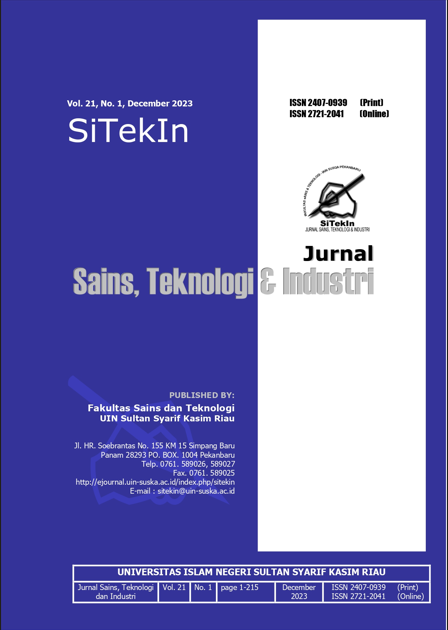The Effectiveness of the Effect of Holding Time on the Toughness and Macro Structure of Low Carbon Steel Due to Carburizing Pack of Pine Charcoal
DOI:
https://doi.org/10.24014/sitekin.v21i1.23332Abstract
This study aims to determine the effectiveness of holding time variation of fir charcoal with oil cooling media SAE 20 on the toughness of low carbon steel ST 37 due to the pack carburizing process. This research method, namely impact test, and macrostructure. In the pack carburizing process using fir charcoal and SAE 20 oil cooling media on the toughness and macrostructure of low carbon steel ST 37. The holding time used is 1,2,3,4 and 5 hours. After the carburizing process, a toughness test and macrostructure observation were conducted. From the results of the toughness test obtained the value of each: 17.513 kJ/mm2 at a holding time of 1 hour, 11.920 kJ/mm2 at a holding time of 2 hours, 13.196 kJ/mm2 at a holding time of 3 hours, 7. 917 kJ/mm2 at a holding time of 4 hour, and 3.081 kJ/mm2. Then for macro photo observations greatly, it can be seen that holding time variations greatly affect the holding time, the more tenuous the steel structureReferences
B. H. Amstead, F. Ostwald Phillip, L. Begeman Myron, and S. Djaprie, “Teknologi Mekanik Jilid II,” Ed. Ketujuh, Erlangga, 1991.
W. D. Callister and D. G. Rethwisch, Materials science and engineering: an introduction, vol. 7. John wiley & sons New York, 2007.
A. D. Krawitz, Introduction to diffraction in materials science and engineering. 2001.
F. Pohan, I. Saputra, and R. Tua, “Scheduling Preventive Maintenance to Determine Maintenance Actions on Screw Press Machine,” J. Ris. Ilmu Tek., vol. 1, no. 1, pp. 1–12, 2023.
I. N. Permadi and D. B. Nisa, “A Model Experiment Design Using the Taguchi Method: A Case Study Of Making Concrete Roof,” J. Ris. Ilmu Tek., vol. 1, no. 1, pp. 36–44, 2023.
N. Nitha, “Pengaruh Pack Carburizing Arang Tulang Kerbau Mesh 30 Dan Temperatur 9500C Terhadap Keausan Baja Karbon Sedang,” Mech. Eng. Sci., vol. 1, no. 1, pp. 14–17, 2019.
Y. B. Nitha, R. Syam, and H. S. Asmal, “Behavior of Low Carbon Steel Mechanical Properties Due Pack Carburizing Media Charcoal Buffalo Bone,” Int. J. Res. Sci. Manag., vol. 4, no. 12, pp. 38–47, 2017.
A. E. Suryana, “Pengaruh Variasi Waktu Tahan (Holding Time) pada Proses Carburizing Terhadap Kekerasan Permukaan dan Ketahanan Aus Baja Konstruksi Umum.” University Of Muhammadiyah Malang, 2019.
G. E. Dieter and D. Bacon, Mechanical metallurgy, vol. 3. McGraw-hill New York, 1976.
G. Filhaq, S. Aprianto, and H. Alfianto, “Design of Smart Locker Door Using Quality Function Deployment Based on ATMega 2560 Microcontroller,” J. Ris. Ilmu Tek., vol. 1, no. 1, pp. 25–35, 2023.
T. M. Sari and W. Dini, “Risk Assessment and Mitigation Strategy in The Halal Broiler Supply Chain,” J. Ris. Ilmu Tek., vol. 1, no. 1, pp. 13–24, 2023.
W. D. Callister Jr and D. G. Rethwisch, Fundamentals of materials science and engineering: an integrated approach. John Wiley & Sons, 2020.
M. N. Murthy, “Fabrication and the impact of Fe and Al substitution on structural, morphological, vibrational and optical properties of Fe: Al co-doping zinc oxide nanostructured thin films developed by Arduino based spin coating device,” Mater. Today Proc., vol. 57, pp. 2166–2173, 2022, doi: 10.1016/j.matpr.2021.12.215.
Y. Küçükağa, “An original Arduino-controlled anaerobic bioreactor packed with biochar as a porous filter media,” MethodsX, vol. 9, 2022, doi: 10.1016/j.mex.2021.101615.
D. A. D. Audrey, “Monitoring Mung Bean’s Growth using Arduino,” Procedia Computer Science, vol. 179. pp. 352–360, 2021. doi: 10.1016/j.procs.2021.01.016.
A. A. A. Sen, “Designing a smart bracelet based on arduino for deaf parents to interact with their children,” Proceedings of the 2021 8th International Conference on Computing for Sustainable Global Development, INDIACom 2021. pp. 380–384, 2021. doi: 10.1109/INDIACom51348.2021.00066.
O. Chamorro-Atalaya, “Level Transducer Circuit Implemented by Ultrasonic Sensor and Controlled with Arduino Nano for its Application in a Water Tank of a Fire System,” Int. J. Adv. Comput. Sci. Appl., vol. 12, no. 10, pp. 464–471, 2021, doi: 10.14569/IJACSA.2021.0121052.
D. M. Waqar, “Design of a Speech Anger Recognition System on Arduino Nano 33 BLE Sense,” 2021 IEEE 7th International Conference on Smart Instrumentation, Measurement and Applications, ICSIMA 2021. pp. 64–69, 2021. doi: 10.1109/ICSIMA50015.2021.9526323.
A. Eltaweel, “An automated louver with innovative parametrically-angled reflective slats: Prototyping and validation via using parametric control in Grasshopper along with Arduino board,” Energy Build., vol. 231, 2021, doi: 10.1016/j.enbuild.2020.110614.
M. Tupac-Yupanqui, “Experiences and benefits of using Arduino in a first-year programming course,” Form. Univ., vol. 14, no. 6, pp. 87–96, 2021, doi: 10.4067/S0718-50062021000600087.
S. S. Mulik, “Development and experimental assessment of a fluid flow monitoring system using flow sensor and arduino interface,” Lecture Notes in Mechanical Engineering. pp. 115–122, 2021. doi: 10.1007/978-981-15-6619-6_12.
Downloads
Published
Issue
Section
License
This work is licensed under a Creative Commons Attribution-ShareAlike 4.0 International License
Copyright Notice
An author who publishes in the SITEKIN Journal agrees to the following terms:
- Author retains the copyright and grants the journal the right of first publication of the work simultaneously licensed under the Creative Commons Attribution-ShareAlike 4.0 License that allows others to share the work with an acknowledgement of the work's authorship and initial publication in this journal
- Author is able to enter into separate, additional contractual arrangements for the non-exclusive distribution of the journal's published version of the work (e.g., post it to an institutional repository or publish it in a book) with the acknowledgement of its initial publication in this journal.
- Author is permitted and encouraged to post his/her work online (e.g., in institutional repositories or on their website) prior to and during the submission process, as it can lead to productive exchanges, as well as earlier and greater citation of the published work (See The Effect of Open Access).
Read more about the Creative Commons Attribution-ShareAlike 4.0 Licence here: https://creativecommons.org/licenses/by-sa/4.0/.

